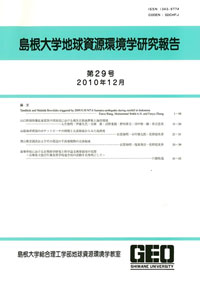島根大学総合理工学部地球資源環境学教室
ISSN:1343-9774

number of downloads : ?
Use this link to cite this item : https://ir.lib.shimane-u.ac.jp/31607
Geoscience reports of Shimane University 33
2015-02-27 発行
福島県東棚倉地域久保田層から産出するAnadara 属二枚貝化石の形態測定
Morphometric analyses of the genus Anadara (Bivalvia; Arcidae) from the Miocene Kubota Formation in the eastern Tanagura area, Fukushima Prefecture, Northeast Honshu, Japan
Suzuki, Takuma
File
Description
The taxonomic classification of the genus Anadara (Bivalvia) from the Miocene Kubota Formation in the eastern Tanagura area has been controversial in previous studies, because there are wide ranges in its shell variation. The present study conducts morphometric analyses of fossil Anadara collected from three localities (Kamitoyo, Kubota, and Tanaka) of the formation as a basic study to describe the morphologic variation through time and space. As a result, the Kamitoyo population can be distinguished from other two populations by its shell shape and ontogenetic pattern. In turn, morphometric differences between Kubota and Tanaka populations should be resulted from an intraspecific variation because these two populations have a common ontogenetic pattern of the shell-coiling mode. According to ontogenetic parameters of hinge teeth, these three populations are placed in the subgenus Anadara. We distinguish the Kamitoyo population into an independent species Anadara (Anadara) tanakuraensis Noda from the rest two populations belonging to Anadara (Anadara) hataii Noda.
Other Article
PP. 19 - 27
